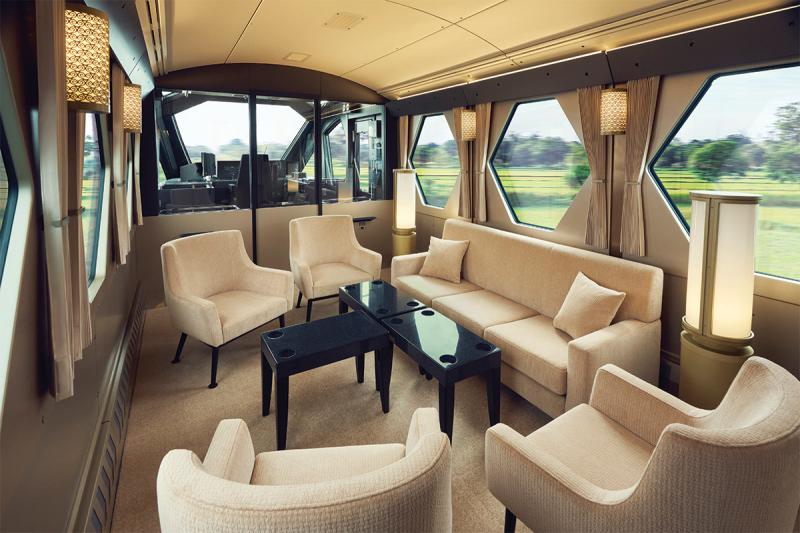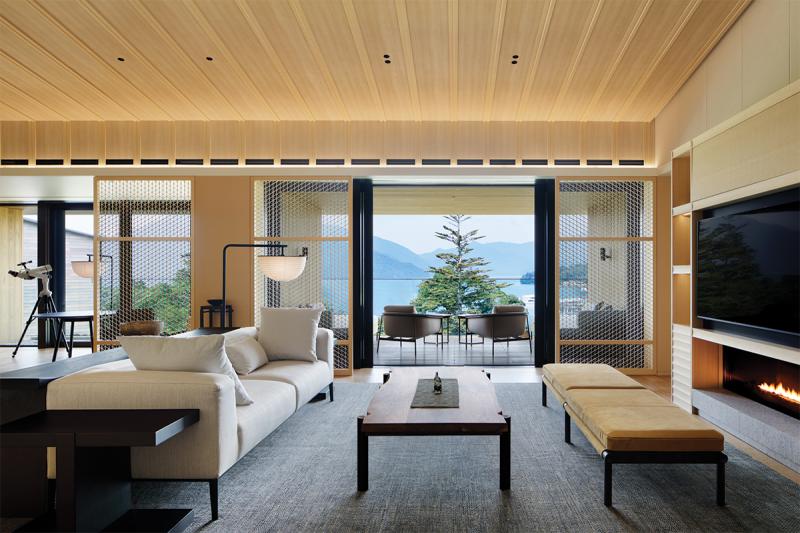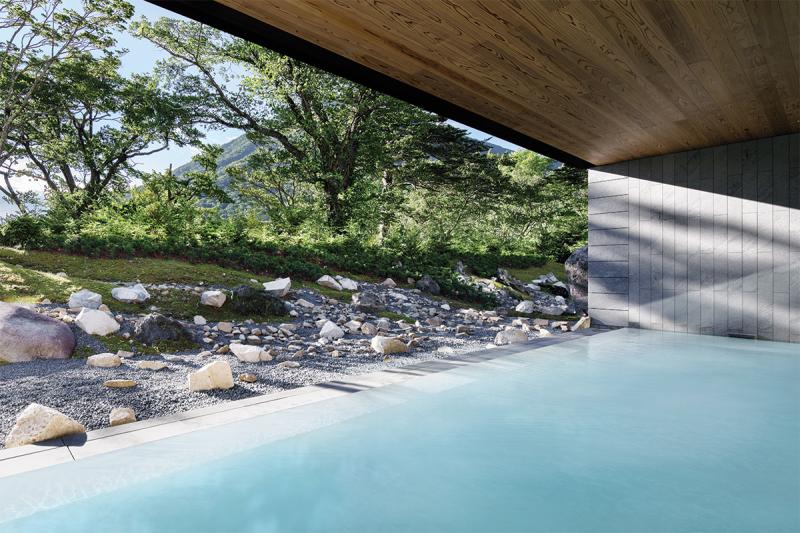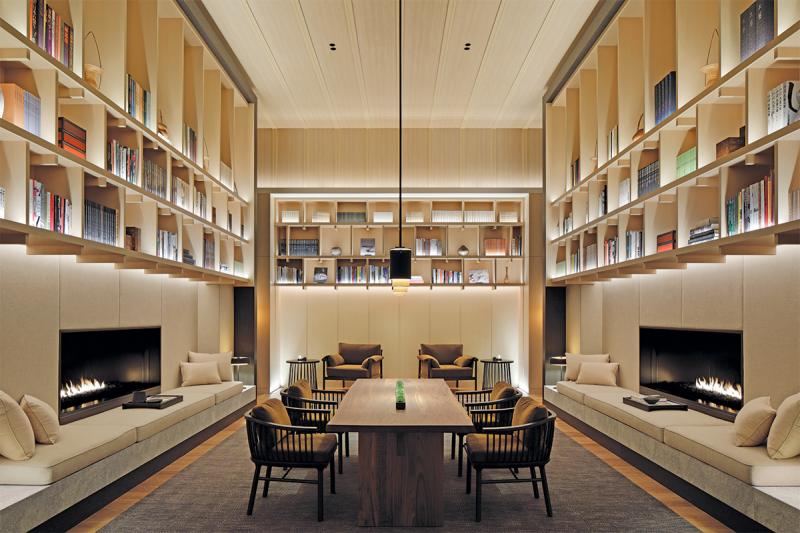Tucked away in northern Japan’s Kanto region, Oku-Nikko has long been a tranquil retreat for well-heeled Japanese and foreign dignitaries, drawn by its serene landscapes and rich cultural heritage. At the heart of the region lies the shimmering Lake Chuzenji, Japan’s highest lake, nestled beneath the sacred, mist-shrouded peak of Mount Nantai. With the opening of The Ritz-Carlton, Nikko in 2020—the brand’s first venture into the Japanese countryside—and the debut of the luxurious Spacia X train service last year, this breathtaking area has never been more accessible to luxury travelers. Luxury Travel Advisor’s Emily Goldfischer visited with her husband and teenage children recently.
For families planning a Japan itinerary, Oku-Nikko is an unmissable destination—and the journey itself is part of the experience. Just two hours from Tokyo on the sleek new Spacia X, launched by Tobu Railway in 2023, this luxury train offers six daily round trips and features an award-winning design that combines Edo-period traditions with modern innovation. With multiple seating options, including compartments, sofas and lounge seats, the standout is the Cockpit Suite, inspired by the cockpit of a private jet. Massive windows offer panoramic views of the rolling scenery, and the plush seats are perfect for relaxing while nibbling on local Nikko-style snacks like Asano pork jerky, smoked Itadaki trout and yokan (sweet bean jelly), washed down with local beers and sake. Honestly, we didn’t want the journey to end!

Once in Nikko, we began to understand why the area is so beloved. The region’s blend of natural beauty, cultural exploration and outdoor activities provides a perfect counterpoint to visiting Japan’s busy cities. Good to know: There are two main areas—central Nikko, where the train station is situated in a small town, and Oku-Nikko (aka the heart of Nikko), home to The Ritz-Carlton on Lake Chuzenji, about a 45-minute drive up a scenic, winding road through a more rural setting.
Arriving on an early train allows ample time to visit the iconic Nikko Toshogu Shrine before heading up to The Ritz-Carlton. A UNESCO World Heritage Site and masterpiece of Shinto-Buddhist architecture, it features intricate carvings like the famous sleeping cat and the lavish Yomeimon Gate. Nearby, Rinnoji Temple, founded in the eighth century, represents the Buddhist heritage of Nikko with its gilded statues of revered deities. We all enjoyed learning about the harmonious blend of Shinto and Buddhist traditions, known as Shinbutsu-shūgō, which has shaped Japan’s spiritual landscape for centuries. Contact Imane Aaqili (rc.nikko.gs@ritzcarlton.com), guest service assistant manager, to arrange a guide and car and driver for VIPs.
Before or after visiting Toshogu, stop at the Nikko Kanaya Hotel, established in 1873 and recognized as Japan’s oldest Western-style hotel. The hotel boasts a rich history, having hosted notable guests such as Albert Einstein and Eleanor Roosevelt, and much of the original structure remains intact—think polished wood floors, vintage furnishings and classic European décor that evoke a bygone era of luxury travel. We enjoyed a lovely three-course lunch in the formal dining room with stunning treetop views, but it would be equally grand to sip a whisky at the cozy Bar Day Site, which offers 200 varieties of single malt whiskies, including its own proprietary blend. If time permits, take a short stroll to the iconic Shinkyo Bridge, a sacred red-lacquered bridge spanning the Daiya River, or at least be sure your driver swings by there for a photo!

Rooms at The Ritz-Carlton, Nikko
Overlooking the majestic Mount Nantai, the 94-room Ritz-Carlton, Nikko, designed by LWK + Partners, strikes a perfect balance between Japanese minimalism and luxury. Located in a lakeside neighborhood once favored by diplomats, the hotel’s elegant spaces reflect the region’s history and culture. From the moment you arrive, a Zen-like tranquility sets the tone as the guest services team warmly greets you with a sweet treat and tea, then seamlessly guides you to your guestroom.
Each guestroom at The Ritz-Carlton, Nikko offers breathtaking views of either Lake Chuzenji, Mount Nantai or the Zen gardens, with a private balcony and engawa Japanese porch that allows guests to fully take in the serene surroundings of Nikko National Park. We stayed in Lake Chuzenji View Room 303. Upon entering, there’s a traditional genkan (foyer) where shoes are removed and slippers put on, setting a distinctly Japanese tone. The design beautifully incorporates natural materials and traditional Japanese craftsmanship, with accents inspired by Kanuma wood latticework, all in soothing tones of beige and brown. The spacious, 614-square-foot room includes an engawa porch with a table and lounge, and an oversized stone bathroom with a Japanese-style soaking tub, double sinks and a separate shower. Nods to Western essentials include a Nespresso machine, Diptyque bath amenities and ample closet space. Our kids stayed in Room No. 309, identical in size with the same lake views, but with two double beds instead of a king.
For VIPs: Book The Ritz-Carlton Suite, a massive 2,981-square-foot space with multiple lounging areas, a full dining room with a kitchen, an office, and a luxurious wet room and bathing area overlooking the lake. The suite also has a private gym, massage room and a full-length engawa porch with several seating areas to enjoy the view. Equally stunning are the nine Lake Chuzenji Suites, a generous 1,237 square feet with living area, massive wet room-style bathrooms and large closets. Nice Touch: All suites come with pajamas. For VIP bookings and room requests, contact Eri Sugimoto (eri.sugimoto@ritzcarlton.com), director of sales.
Dining
Dining at The Ritz-Carlton, Nikko highlights premium ingredients sourced from regional growers, such as Ebihara Farm, which cultivates over 90 varieties of vegetables throughout the year. For dinner, we opted for the exquisite nine-course Kaiseki menu, a journey through local flavors. Highlights included grilled golden sesame tofu with sea urchin, Tochigi wagyu beef with turnips and salted rice malt ice cream. Each dish was crafted with precision, celebrating the region’s rich produce, and was both beautifully presented and delicious.

Breakfast was equally impressive, complete with a large bento-style box filled with Japanese or Western small plates, plus freshly prepared breads, as well as a buffet with yogurts, cereal, and drinks and our personal favorite, a sweet egg custard. Lakehouse, the hotel’s western dining restaurant, overlooks Lake Chuzenji with Michelin 2-star chef Kanji Kobayashi of villa aida currently overseeing the farm-to-dining Western menu with seasonal dishes. In the bar area, guests can enjoy traditional afternoon tea or ramen at night, complemented by an extensive selection of Japanese whiskies organized by region.
Spa + Wellness
The spa and onsen area at The Ritz-Carlton, Nikko is a serene sanctuary, beginning with the pretty pebble-lined walkway inspired by the geological layers of the nearby Iroha Slopes. Both indoor and outdoor onsen draw natural sulfuric water from the historic Yumoto Onsen, renowned for over 1,200 years. The onsen’s hydrogen sulfide sulfur springs are naturally heated to 173.5 degrees Fahrenheit and turn milky white when exposed to air, create a soothing, restorative experience. We made full use of the peaceful onsens, steam room and sauna several times during our stay. The spa also houses a gym and four treatment rooms. While we didn’t have time for a treatment, Spa Manager Kumiko Kishida (kumiko.kishida@ritzcarlton.com) shared that the signature offering is the "Nature Immersion," a calming treatment that includes a soothing full-body massage that utilizes a warm bamboo wand to stimulate reflex points, and peony-scented essential oil that nourishes the skin, improving clarity and tone.

Experiences
Although Oku-Nikko spans less than 12 miles, its diverse landscape—ranging from lakes and mountains to wetlands and forests—offers a wealth of outdoor activities, including hiking, cycling and fishing. Kegon Falls, one of Japan’s top three waterfalls, lives up to the hype with its dramatic 318-foot drop into a gorge. Senjogahara Marshland is another must-see, where visitors can hike through vibrant red and yellow grasses in the fall, and enjoy bird-watching year-round. In the summer, Lake Chuzenji becomes a hub for water sports like stand-up paddleboarding (SUP), while the cooler months transform the area into an ideal spot for skiing and snowshoeing. The resort offers extensive Ritz Kids programming for little ones, which means parents can pick and choose time alone and as a family. Contact Aaqili for arrangements.

During our late summer visit, the resort’s proximity to several former summer residences of European embassies, built around Lake Chuzenji in the late 19th century, added to the charm. We began our day with a walk along the lake and a tour of the British residence, followed by a visit to Chuzenji Temple, where, as Guest Experience Captain David informed us, wishes are granted. Although our plans for a bike tour and speedboat ride on the lake were scuppered by rain, the guided walk and a wonderful wood carving class with local artisans, where we designed and carved our own boxes for several hours, made for an unforgettable experience.
Best times to visit: Autumn for the foliage, while summer as the Nikko area is about 10 degrees cooler than Tokyo.
Good to know: While we traveled as a family, the hotel’s serene ambiance, modern Japanese design, and stunning rooms also make it an ideal spot for honeymooners or a romantic getaway.
Related Articles
InsideJapan Tours Increases “Small Group Tour” Offerings
Now Open: Four Seasons Hotel Osaka